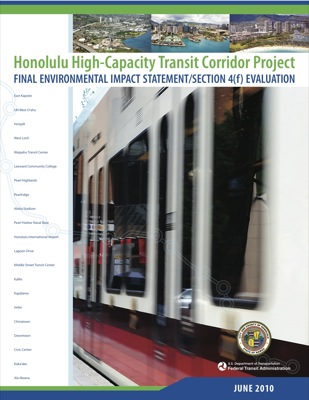Hawaii – Land of Crony Capitalism » The Antiplanner
Hawaii – Land of Crony Capitalism
Travels |June 28, 2010
Honolulu’s Rail Plan
posted in Transportation, Urban areas |Yesterday, in response to the Antiplanner’s post about crony capitalism, Scrappy commented that Honolulu needs rail transit to “reduce our carbon footprint, save energy and get us off the maddening addiction to cars.” He added that, “the environmental community in Honolulu is strongly behind rail.”
I appreciate Scrappy’s comment and don’t want to discourage him from participating in this forum, but I find it sad that my former colleagues in the environmental movement have become so innumerate that they would support a turkey like the Honolulu elevated rail plan. The final environmental impact statement for that project is now available. Let’s see what it says about saving energy, carbon, and driving.

Start with energy. Table 4-21 of the FEIS says the project will save 396 million British thermal units (BTUs) of energy each day, or 144,540 million BTUs per year. Sounds great, except that page 4-206 says project construction will cost 7.48 trillion BTUs. That means it will take 52 years of savings to pay back the energy cost. Long before 52 years are up, huge energy investments will be needed to replace rail cars, worn out track, and other infrastructure. So there is likely no net energy savings.
How about reducing our carbon footprint? According to page 68 of the Department of Energy’s State Energy Guide, more than 90 percent of Hawaii’s energy comes from burning fossil fuels. Scrappy points out that “the local power utility is making a big push to use renewables in its fuel mix,” but good intentions are not enough. Even if it can find some renewable sources of energy, it would be better to use that electricity to offset some of the electricity now being used by Oahu residents, not to create a new source of energy demand.
Page 4-113 of the FEIS predicts that the project will save all of 171 tons of carbon dioxide emissions per day, or about 62,415 tons per year. Page 6-2 says construction will cost nearly $4.3 billion, which amortized out at a generous 4 percent works out to $245 million per year. Add the anticipated $72 million in operating costs (p. 6-8) and divide by the tons of CO2 saved and you get a cost of just over $5,000 per ton. Since the going rate for carbon credits right now is less than $20 per ton, and McKinsey says we can meet carbon reduction targets if we spend no more than $50 per ton, anything that costs $5,000 per ton should absolutely be rejected by people who care about our carbon footprint.
Note that the FEIS did not estimate the tons of CO2 that will be released during construction, which will offset much if not all of the projected savings.
Will the project help “get us off the maddening addiction to cars”? The Antiplanner isn’t even sure that this should be considered a benefit, since cars are less expensive, more convenient, and really have no greater environmental impact than transit. Even so, the FEIS predicts that the project will reduce the number of regional auto trips per day by 51,200 out of 3,003,400 trips under the no-build alternative. That is a 1.7 percent reduction. That means Honolulu would only need to build 59 more rail lines, at a cost of more than a quarter of a trillion dollars (roughly the cost of the entire Interstate Highway System), to eliminate the city’s addiction to autos.
Of course, all of the FEIS’s estimates of energy, carbon, and other savings depend on its projection that the 20-mile rail line will carry 116,300 riders per day (page 3-5). That’s more than San Diego’s 51-mile light-rail system, almost twice as many as Miami’s 28-mile elevated rail, and more than twice as many as St. Louis’ 48-mile elevated light-rail system. So there are reasons to be skeptical of the Honolulu projections.
Scrappy did not say anything about congestion, but he mentioned that the region’s voters supported the rail plan (by a tiny margin). One reason they did so is that rail supporters emphasized that the project would “ease traffic congestion.” Of course, they lied when they said this, as page 3-51 of the FEIS says that traffic delays will be worse at every intersection with the project than without it. “Mitigation,” meaning widening roads and improving traffic signals, will help at a few intersections, but then why can’t they just do the mitigation and not the rail project?
The environmentalists who support this wasteful project are the Baptists of a Baptists and bootleggers coalition that is promoting rail transit throughout the country. The bootleggers, of course, are the crony capitalists who will make tens or hundreds of millions in profits building this unsightly monstrosity. I hope in the future more environmentalists will open their eyes and support things that are truly good for the environment, not just feel-good projects that cost a lot of money.

No comments:
Post a Comment